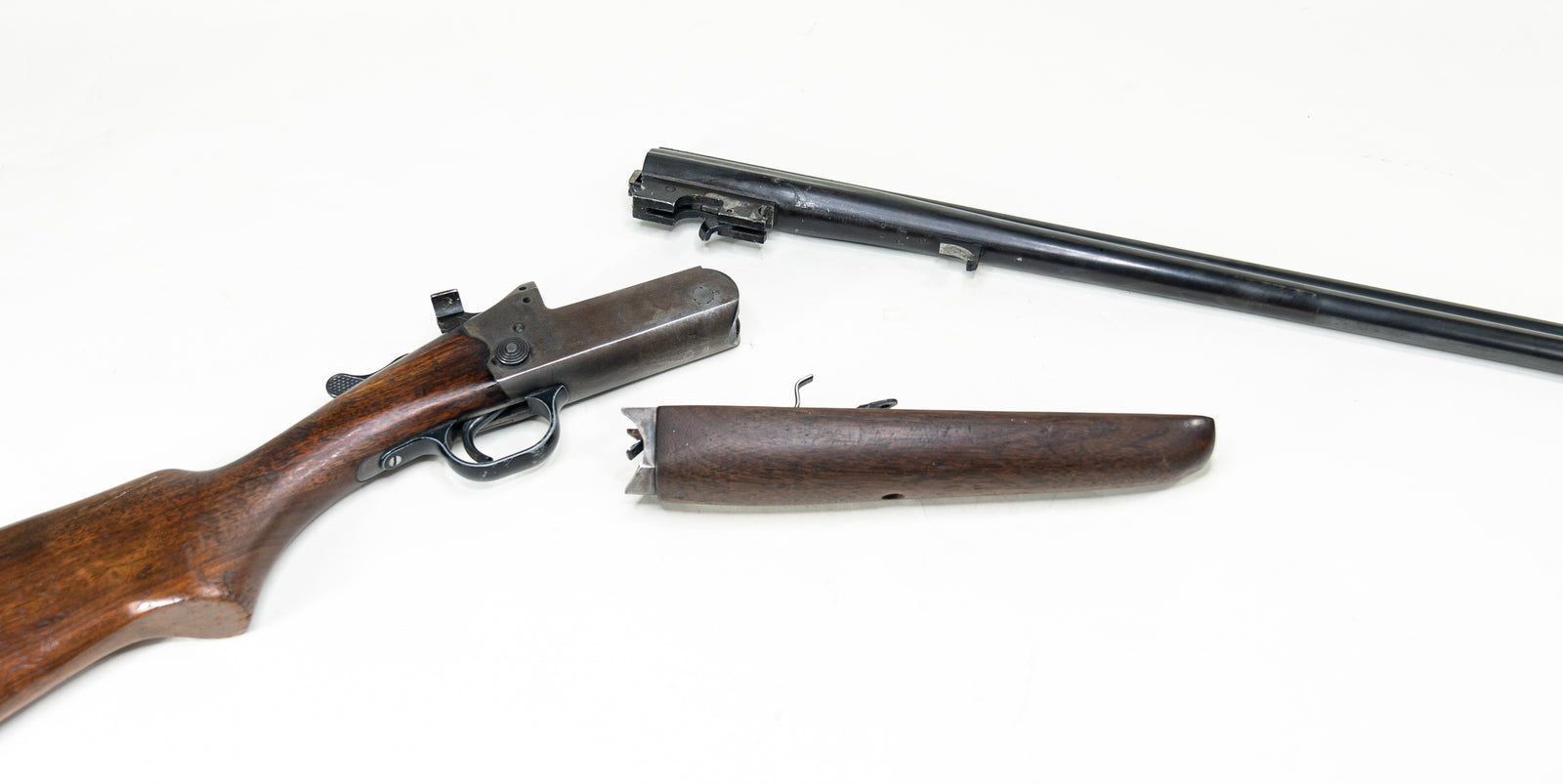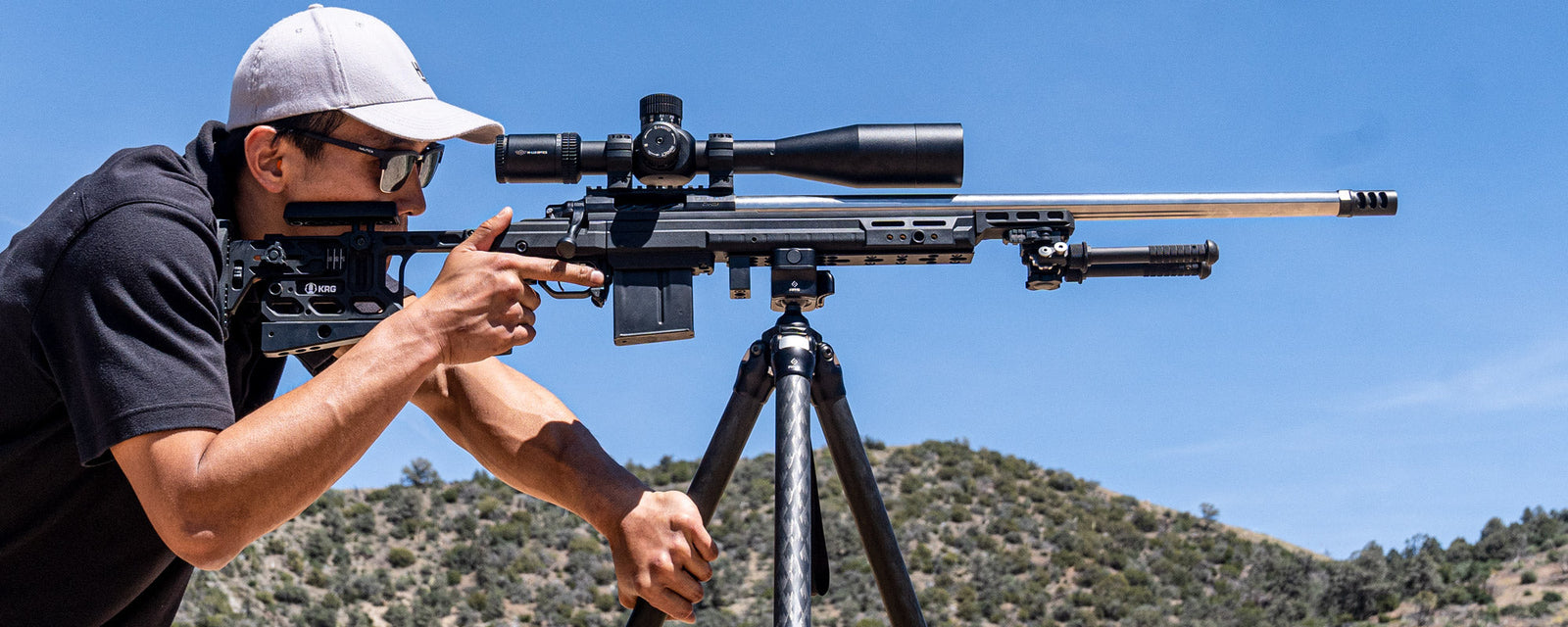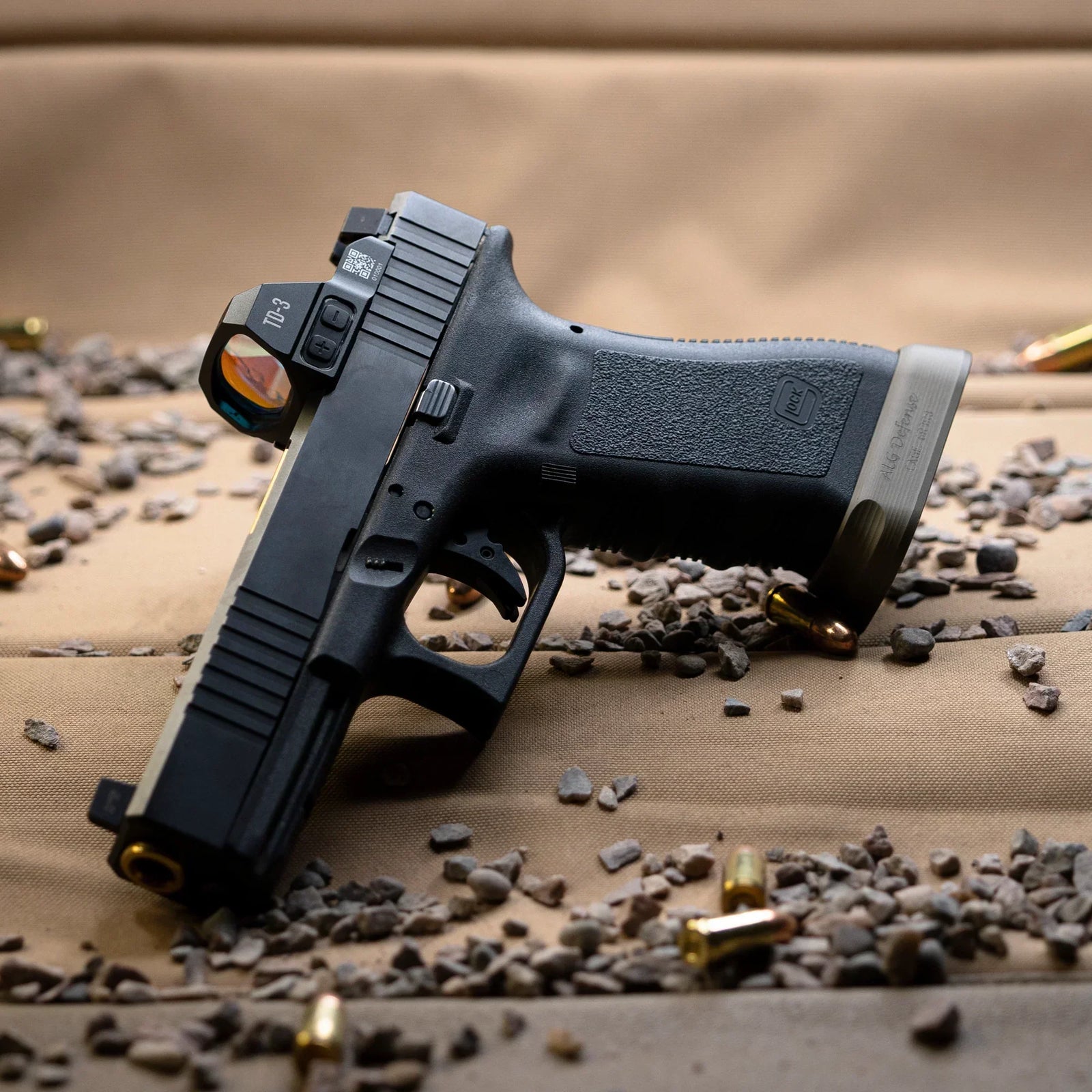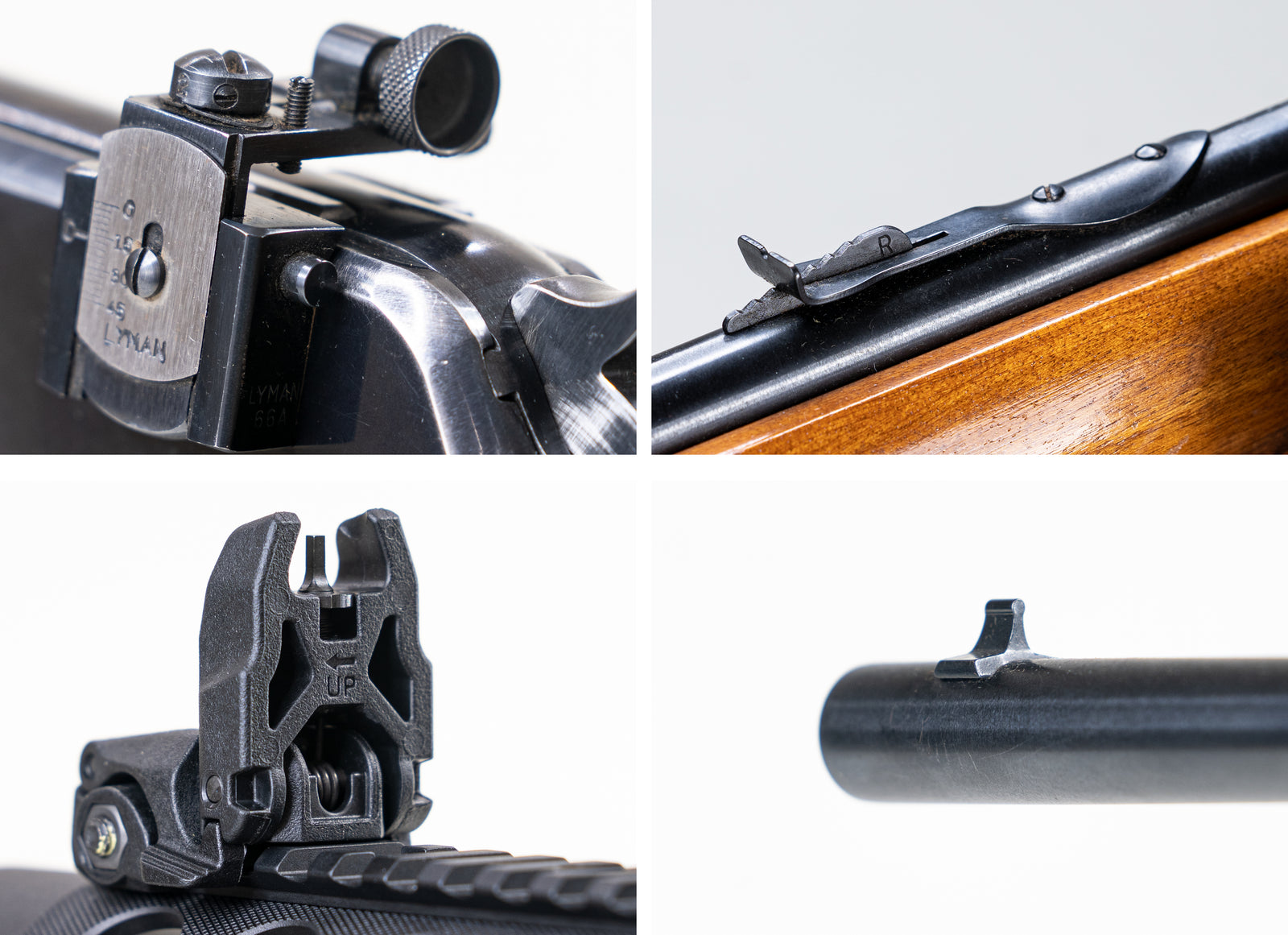The stock provides a home for all the other parts of a rifle. In general terms, a stock is usually shaped like a narrow fin at the end of a long arm. Whether made of metal, plastic, or wood, the stock is an integral part of a rifle not unlike a skeleton. In the middle is the receiver, which houses the action - the heart of the rifle. Hanging below the receiver is the trigger, which sets the firing pin in motion. The stock is roughly divided into two zones - the stuff behind the trigger and the stuff in front of the trigger. Some stocks are made up of one continuous piece that goes the entire length from the front to back end of the stock. Other stocks will divide quite readily into their front and rear halves, separated by the receiver.

The stock of a rifle, attached and separate. In the case of this rifle, the stock is made out of a single piece of wood.
The Forend
The stuff in front of the trigger is called the fore-end (forend). This is the half on the side of the muzzle, which points away from you. The fore-end may help hold the receiver and barrel together. If the forend is attached to the barrel via a recoil lug, it helps transmit some of the force of the recoil from the barrel to the stock.
Having a stock that attaches to the barrel is avoided in precision long-range rifle shooting. As environmental conditions change - humidity especially, but temperature too - wooden stocks will shrink and swell. If they’re contacting the barrel, this pressure can cause the barrel to shift alignment in relation to the receiver. Even if the shift is small, the ramifications down-range can be enormous.
Having a recoil lug in the fore-end of the stock is in contrast to free-floated barrels, where the barrel only attaches at the receiver. In practice, a free-floating barrel should never touch the stock at any location. A free-floating barrel allows the barrel to vibrate and react under its own harmonics, and keeps the shifting from environmental factors down to a minimum. Barrel harmonics can lead to a lengthy conversation when you get to reloading, and I recommend you look into the particulars of your barrel whenever possible. Not unlike a musical instrument, your rifle can be tuned.
Alternatively, the barrel may be held only along a portion of its length - as in partially free floated barrels. Otherwise, the barrel may be set into a different material than the normal stock that is not responsive to moisture or temperature - see the section on glass bedding a few paragraphs down.
The forend of the rifle is also generally where you’ll place a hand for certain shooting positions. Depending on the type of rifle and style of shooting, you may grab under the barrel where the stock extends forward, or fully around the barrel on the barrel shroud. The barrel shroud is a sheathe of metal that sits suspended around the barrel at a slight distance, keeping you from potentially having your hand on a hot barrel or gas tube. The forend may also contain attachments for items such as a bipod below the barrel, a sight above the barrel, or other accessories to the sides.

A barrel somewhat hidden inside a barrel shroud, free floating.
Where the Receiver Sits
The receiver rests in the middle of the stock, over the trigger group. The receiver is the frame that allows everything else to have a home - the hammer, the bolt - and provides attachment points for the rifle components such as the barrel, trigger, and stock. Additionally, some receivers may be drilled and tapped (or modified in other ways) to attach a sight or mounting rail. In other cases, the sight may mount directly on the stock, or even on the barrel. This is all to say - sights of any sort often do not mount to the stock.
The receiver normally sits fastened in the stock with screws, pins, and pressure. As such, it may be prone to shifting - especially if the stock is made of wood. In times like this, the receiver or action may benefit from bedding in some other material.
Bedding is the process of securing the receiver or action into the stock via some epoxy or resinous material that provides a full contact across all possible surfaces. This helps keep the receiver from shifting around in relation to the stock, which would be sure to throw off precision. As an added bonus - this process also seals wood stocks against some moisture.
The bedding on a well-made rifle should only enhance the existing inletting, where the fitted the action or receiver into the rest of the stock. If the inletting is of poor quality (for example, the size is quite wrong or the surface is poorly done), bedding should not be considered a fix. Get the foundation - the inletting - of high quality before you finish it off with quality bedding.
Receivers are typically considered the actual firearm when it comes to legality, and are thus the item that’s serialized. For rifles such as the AR-15, the receiver is actually made of two segments (the upper and lower receivers), and the legally controlled part is the one that ends up being serialized. Certain productions of rifles, especially old collectible rifles, may have serial numbers on many other components to ensure a match of pieces.

Highlighting the receiver on a Winchester 1873. Some rifles will have a large receiver, some will have a rather simple and small one. Regardless of the shape, the receiver is meant to hold all the important mechanical bits.
The Butt
The butt (also known as the buttstock) is the rear end of the stock, which presses against your shoulder when firing. The buttstock may have a comb on it, a portion that rises out from the level of the stock to lift the shooter’s cheek level. The comb may be quite useful if you’re planning on running an optic of some sort, as these sit above the level of the bore.
At the face pressing against your shoulder, the top is known as the heel. Depending on how you hold your rifle, this corner may contact your shoulder. Padding of some sort is usually recommended! The bottom of the butt, typically narrower than the heel, is the toe. The toe will typically be the contact point for an AR-15.

The butt end of the rifle. This end of the rifle won’t have many moving parts unless you have a very fancy stock.
Many Different Wrists
The portion of the rifle that connects the rear end of the receiver to the broader fin of the buttstock is the wrist. Some rifles have a wrist that tapers and bends to act as a grip, while others will have a separate pistol grip hanging behind the trigger. If the wrist connects to the buttstock through a rather broad wrist, it may have a thumbhole to allow a proper grip.
A straight grip stock is one where the wrist is rather straight and forces your human wrist to bend to grip it. The semi-grip stock is more common among hunting rifles, where the wrist curves down at a more extreme angle to allow a lightly angled human wrist grip. The pistol grip allows your human wrist to stay straight, putting the trigger finger more in line with a straight trigger pull. Among precision rifles, a pistol grip is as common as a semi-grip stock, and often more so in long range benchrest.

A handful of wrists and grips (pun intended). The pistol grip keeps your wrist straight, while the others require more (human) wrist mobility.
More Stock Terms
A few useful terms: the drop at comb is the distance from the sightline to the level of the comb (cheek position). If you try a few rifles and find that a particular drop at comb gives you a good cheek weld, you can apply this measurement to rifles you’re considering buying or when choosing upgrades to the stock.
A cheek weld is simply how you stick your cheek to the rifle in order to support your head. If your head is unsupported, it will be difficult to hold it in a consistent spot. A consistent cheek weld means a consistent placement of your face against the stock. If you can expect your face to return to the right spot each time, you’ll spend less time getting into the right position to use your sights.
The recoil arm is a difference in height between a line drawn straight through the bore and the line where recoil acts on the shoulder. If the line of bore lines up with the recoil line (the recoil arm has 0 length), this means the rifle will recoil straight back through the shoulder and reduce the chance of the muzzle moving from recoil. More often, the barrel will sit slightly higher than where the stock contacts your shoulder. This means the recoil arm is greater than zero, and the recoil will throw your barrel up and back. That is the reason behind muzzle rise.

A simple diagram showing the recoil arm and a proper cheek weld.
What Are Stocks Made Of?
Stocks can be made from a variety of materials, but the most common three are: wood, plastic (or composite), and metal.
Wood stocks are among the most common in hunting rifles and vintage rifles. The quality of wood stocks can vary highly, but it does provide a wonderful material to carve into a custom shape. Wooden stocks can fit all variety of upgrades, including adjustable cheek pieces and replaceable butt plates, often incorporating some sort of padding or softer rubberized material. Wood stocks are the most responsive to weather changes, swelling with moisture and shrinking or drying out with heat. They do tend to be among the lightest of stock materials.
Laminated wood combines the machinability and beauty of wood with layering and glue. By layering the wood properly and gluing securely, the effects of moisture can be reduced to a great degree. Laminated wood stocks are usually made of layers roughly 1/16” thick, which can be dyed and cut in certain ways to imitate the effect of true wood grain. Laminate wood stocks are often much stronger than true wood stocks, as the epoxy combined with the lack of defects creates an overall more sturdy structure. Unfortunately, laminated wood stocks tend to be correspondingly denser and heavier than true wood stocks.
Injection molded synthetic stocks are among the easiest for manufacturers to produce. Through the use of high quality precision molds and the right plastics, the stocks can be made at the right size and require minimal finishing. These stocks tend to be fairly light. Among the main drawbacks are the lack of rigidity and a weakness to excess temperatures.
The heaviest stocks tend to be made almost completely out of metal. Metal stocks (or, chassis) offer many advantages, such as thin components with greater overall strength than other materials. They are considerably more resistant to water and weather than wood stocks, though rust can be a concern if the rifle is poorly maintained. These stocks often have the greatest potential for upgrades, as you can drill many different mounting points throughout the chassis without compromising the overall structure. The potential for greater weight (and the ability to attach more weights without issue) can be helpful in reducing the effects of recoil - a useful trait for long range accuracy.

A look at the most common stock materials. Each material has its pros and cons, mostly relating to weight and durability. Also - there’s prettier examples of wood stocks out there and in this book. I included this rifle because it was feeling left out
Butt Upgrades
Though less common in most precision rifles, the buttstock can have a few other potential upgrades that make transportation easier:
A telescoping stock is one with a buttstock that can be extended and shortened. This makes the rifle not only capable of fitting into a slightly shorter case, but also presents the chance for the stock to be a closer fit to a different body size. This is more common among AR-variant rifles.
A folding stock is much more common among AK or modern military platforms. This sort of stock folds at a hinge usually behind the grip. The rifle will typically work fine with the stock extended or folded, but a folded stock offers no shoulder support and is correspondingly more likely to be unstable.
If you’re aiming to shoot at long range, you will require a fine level of precision. Don’t jeopardize your precision by adding mechanical weak points to the system. Get a relatively plain stock that doesn’t telescope or fold, and you’ll be all the happier for it.





Leave a comment (all fields required)